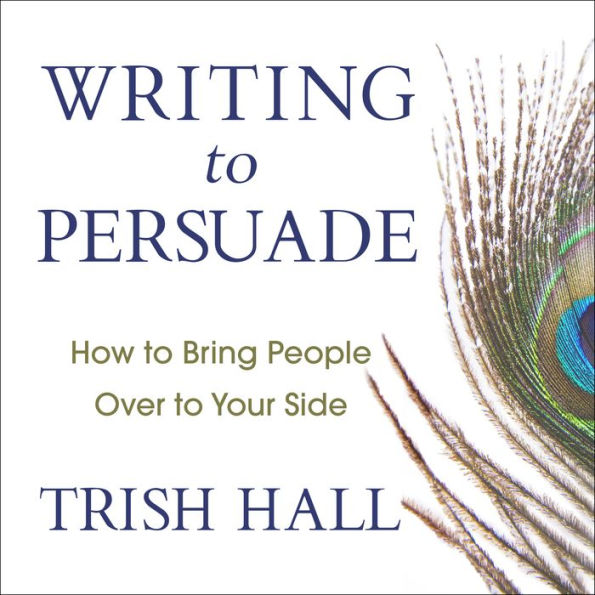…convincingly demonstrates that beliefs always outweigh facts, whether the believers are educated or uneducated, liberal or conservative "or something else altogether"…Hall is a skilled and insightful writer who knows how persuasion happens…But her book isn't just about writing; it's about influencing anyone at all, whether in writing or in life.
From the former New York Times Op-Ed page editor, a definitive and entertaining resource for writers of every stripe on the neglected art of persuasion.
In the tradition of The Elements of Style comes Trish Hall's essential new work on writing well-a sparkling instructional guide to persuading (almost) anyone, on (nearly) anything. As the person in charge of the Op-Ed page for the New York Times, Hall spent years immersed in argument, passion, and trendsetting ideas-but also in tangled sentences, migraine-inducing jargon, and dull-as-dishwater writing. Drawing on her vast experience editing everyone from Nobel Prize winners and global strongmen (Putin) to first-time pundits (Angelina Jolie), Hall presents the ultimate guide to writing persuasively for students, job applicants, and rookie authors looking to get published. She sets out the core principles for connecting with readers-laid out in illuminating chapters such as "Cultivate Empathy," "Abandon Jargon," and "Prune Ruthlessly." Combining boisterous anecdotes with practical advice, Hall offers an infinitely accessible primer on the art of effectively communicating above the digital noise of the twenty-first century.
1129630896
In the tradition of The Elements of Style comes Trish Hall's essential new work on writing well-a sparkling instructional guide to persuading (almost) anyone, on (nearly) anything. As the person in charge of the Op-Ed page for the New York Times, Hall spent years immersed in argument, passion, and trendsetting ideas-but also in tangled sentences, migraine-inducing jargon, and dull-as-dishwater writing. Drawing on her vast experience editing everyone from Nobel Prize winners and global strongmen (Putin) to first-time pundits (Angelina Jolie), Hall presents the ultimate guide to writing persuasively for students, job applicants, and rookie authors looking to get published. She sets out the core principles for connecting with readers-laid out in illuminating chapters such as "Cultivate Empathy," "Abandon Jargon," and "Prune Ruthlessly." Combining boisterous anecdotes with practical advice, Hall offers an infinitely accessible primer on the art of effectively communicating above the digital noise of the twenty-first century.
Writing to Persuade: How to Bring People Over to Your Side
From the former New York Times Op-Ed page editor, a definitive and entertaining resource for writers of every stripe on the neglected art of persuasion.
In the tradition of The Elements of Style comes Trish Hall's essential new work on writing well-a sparkling instructional guide to persuading (almost) anyone, on (nearly) anything. As the person in charge of the Op-Ed page for the New York Times, Hall spent years immersed in argument, passion, and trendsetting ideas-but also in tangled sentences, migraine-inducing jargon, and dull-as-dishwater writing. Drawing on her vast experience editing everyone from Nobel Prize winners and global strongmen (Putin) to first-time pundits (Angelina Jolie), Hall presents the ultimate guide to writing persuasively for students, job applicants, and rookie authors looking to get published. She sets out the core principles for connecting with readers-laid out in illuminating chapters such as "Cultivate Empathy," "Abandon Jargon," and "Prune Ruthlessly." Combining boisterous anecdotes with practical advice, Hall offers an infinitely accessible primer on the art of effectively communicating above the digital noise of the twenty-first century.
In the tradition of The Elements of Style comes Trish Hall's essential new work on writing well-a sparkling instructional guide to persuading (almost) anyone, on (nearly) anything. As the person in charge of the Op-Ed page for the New York Times, Hall spent years immersed in argument, passion, and trendsetting ideas-but also in tangled sentences, migraine-inducing jargon, and dull-as-dishwater writing. Drawing on her vast experience editing everyone from Nobel Prize winners and global strongmen (Putin) to first-time pundits (Angelina Jolie), Hall presents the ultimate guide to writing persuasively for students, job applicants, and rookie authors looking to get published. She sets out the core principles for connecting with readers-laid out in illuminating chapters such as "Cultivate Empathy," "Abandon Jargon," and "Prune Ruthlessly." Combining boisterous anecdotes with practical advice, Hall offers an infinitely accessible primer on the art of effectively communicating above the digital noise of the twenty-first century.
19.99
In Stock
5
1

Writing to Persuade: How to Bring People Over to Your Side

Writing to Persuade: How to Bring People Over to Your Side
FREE
with a B&N Audiobooks Subscription
Or Pay
$19.99
19.99
In Stock

Editorial Reviews
Product Details
| BN ID: | 2940170272037 |
|---|---|
| Publisher: | HighBridge Company |
| Publication date: | 06/11/2019 |
| Edition description: | Unabridged |
Videos

From the B&N Reads Blog
